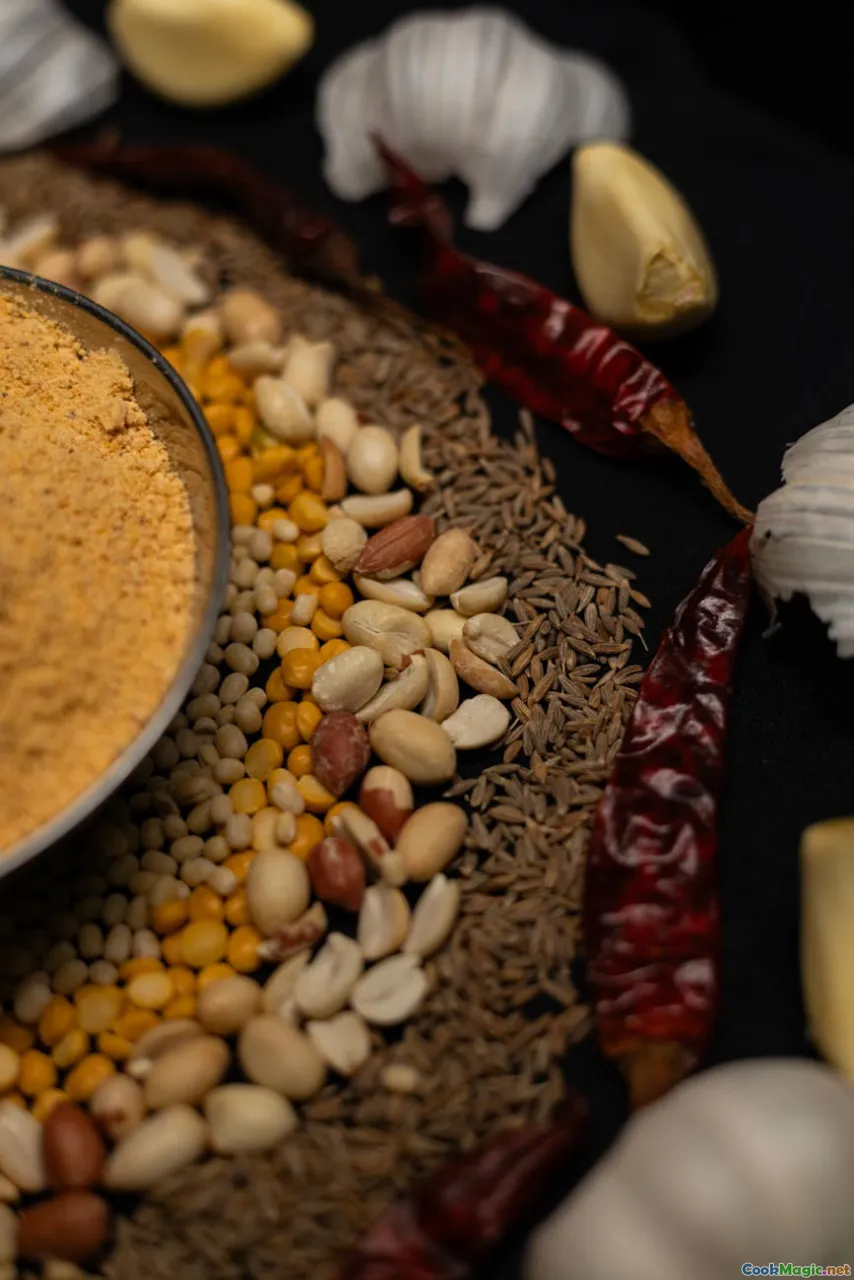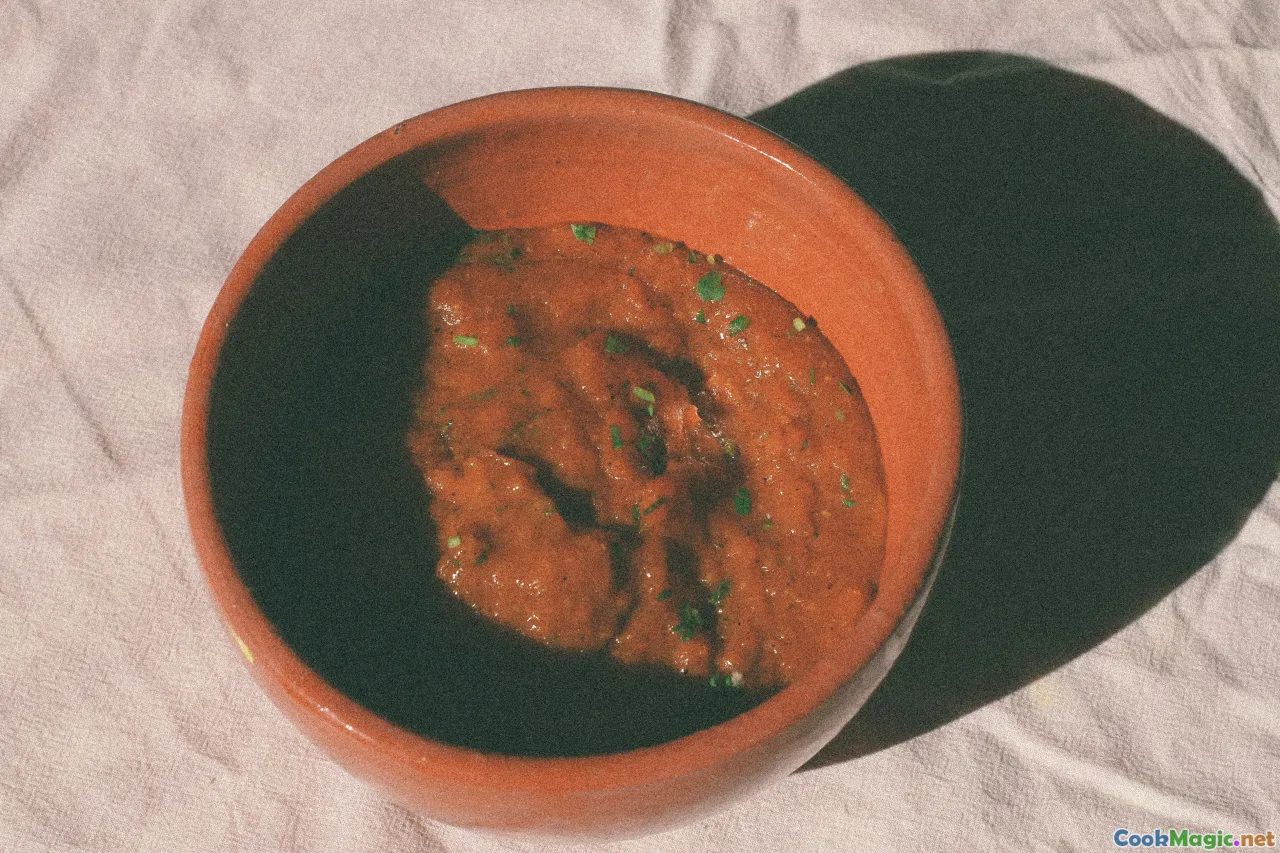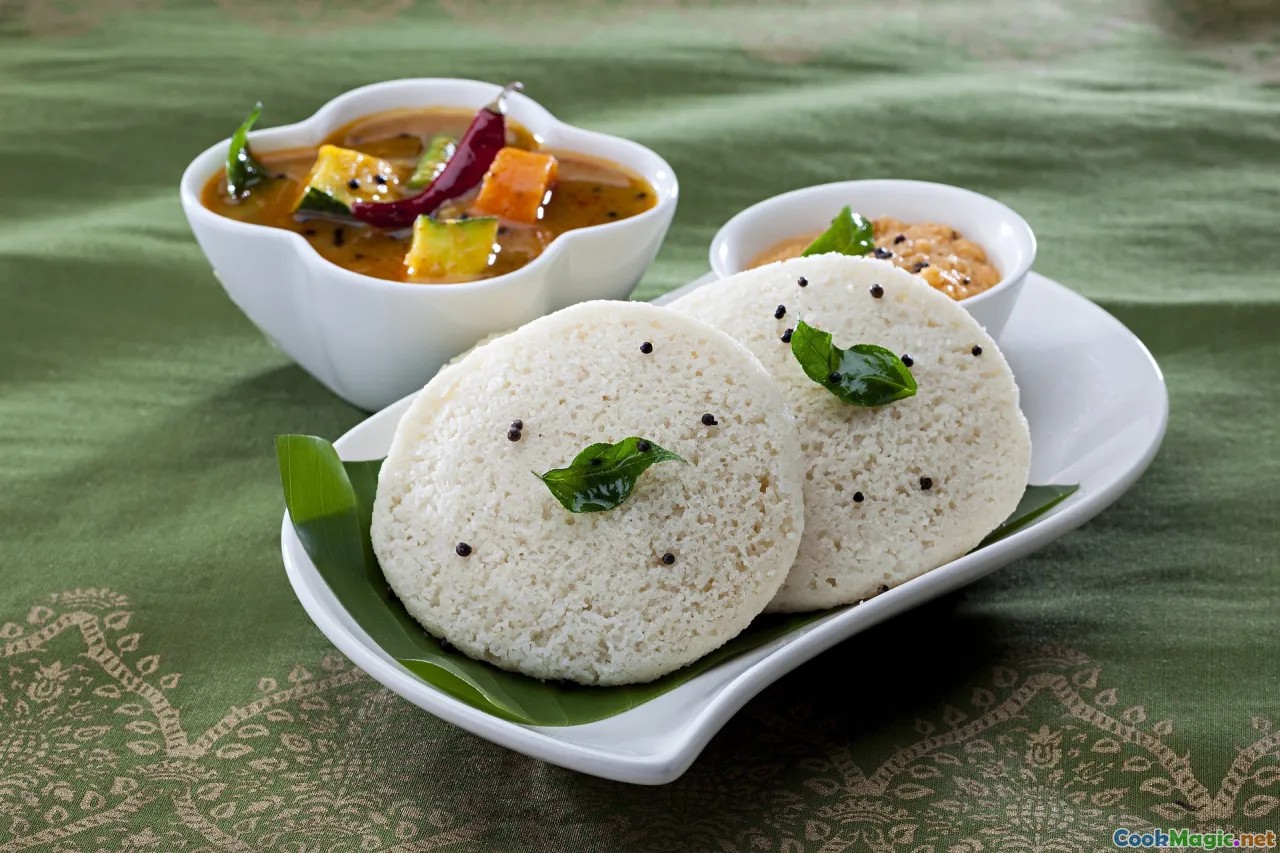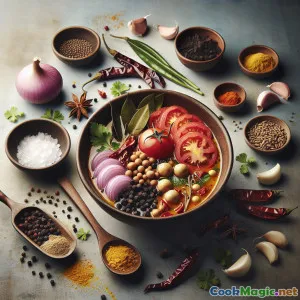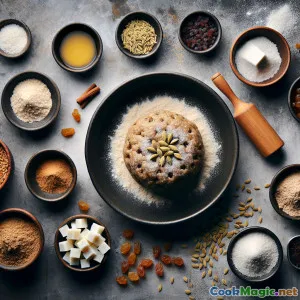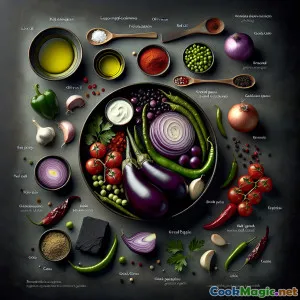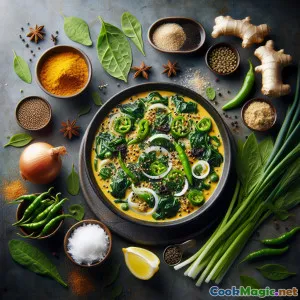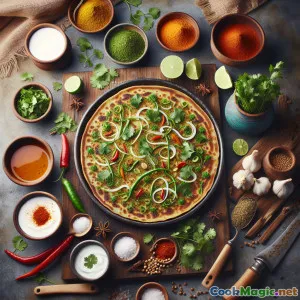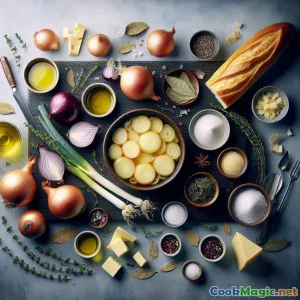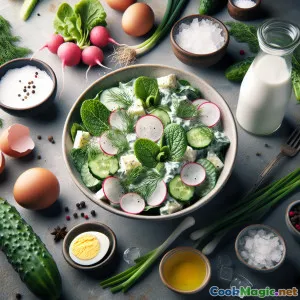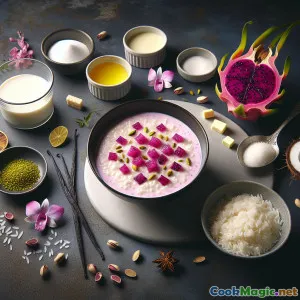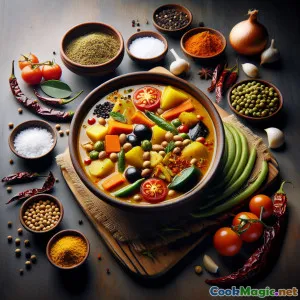
Sambar Chidambaram Kathamba : Ragoût de Lentilles et Légumes Nourrissant
(Chidambaram Kathamba Sambar: Hearty Lentil-Veggie Stew)
(0 Avis)0
508
juillet 22, 2025
Signaler un problème
Ingrédients
-
150 grams Lentilles Toor (pois chiches cassés)
(Washed and soaked for 30 mins)
-
400 grams Légumes mélangés comprenant carottes, pommes de terre, aubergines, courge, haricots et moringa, apportant couleur et nutrition aux plats.
(Chopped into cubes)
-
3 tablespoons Pulpe de tamarin
(Soak in ⅓ cup warm water, extract juice)
-
2 medium Tomates
(Haché)
-
1 medium Oignon
(Haché finement)
-
4 tablespoons Noix de coco râpée fraîche
(For masala paste)
-
1 teaspoon Grains de poivre noir
-
1.5 tablespoons Graines de coriandre
-
4 whole, dried Piments rouges
-
1 teaspoon Graines de cumin
-
16 leaves Feuilles de curry
(Divided for masala paste and tempering)
-
0.5 teaspoon Poudre de Curcuma
-
0.25 teaspoon Asafoetida
-
1 teaspoon Graines de moutarde
-
0.5 teaspoon Graines de Fenugrec
-
2 tablespoons Huile raffinée (sésame/arachide/coco)
-
1.5 teaspoons Sel
(À votre goût)
-
1 teaspoon Jaggery
(Optional, for hint of sweetness)
-
2 tablespoons Feuilles de coriandre fraîches
(Haché, pour garnir)
(Washed and soaked for 30 mins)
(Chopped into cubes)
(Soak in ⅓ cup warm water, extract juice)
(Haché)
(Haché finement)
(For masala paste)
(Divided for masala paste and tempering)
(À votre goût)
(Optional, for hint of sweetness)
(Haché, pour garnir)
Nutrition
- Portions: 4
- Taille de portion: 1 bol (~300 g)
- Calories: 312 kcal
- Carbohydrates: 54 g
- Protein: 12 g
- Fat: 7 g
- Fiber: 10 g
- Sugar: 8 g
- Sodium: 700 mg
- Cholesterol: 0 mg
- Calcium: 120 mg
- Iron: 2.9 mg
Instructions
-
1 - Pressure Cook Lentils:
Pressure cook soaked toor dal with 3 cups water, a pinch of turmeric and a little oil, for 3-4 whistles, until soft. Mash well and set aside.
-
2 - Prepare masala paste:
Heat 1 tsp oil in a pan. Fry black pepper, coriander seeds, cumin, dry red chilies (break if large), half the curry leaves until aromatic. Add coconut, toast for 1 min, then grind everything to a smooth paste adding just enough water.
-
3 - Cook Vegetables:
Boil or pressure cook mixed vegetables and onions, along with a pinch of turmeric and salt, till soft but not mushy (about 80% cooked).
-
4 - Combine and simmer:
Add the mashed lentils, cooked vegetables, tomato, masala paste, and tamarind extract into a large pan. Pour up to 3 cups water to reach desired sambar consistency.
-
5 - Season the Sambar:
Add salt, remaining turmeric, and optional jaggery. Bring to a simmer, stirring well and cook for 10 minutes until raw smell vanishes, and flavors meld.
-
6 - Tempering:
In a small pan, heat remaining oil, add mustard seeds, fenugreek, asafoetida and remaining curry leaves. Once the mustard pops, pour tempering over the sambar.
-
7 - Garnish and Serve:
Garnish with fresh coriander leaves. Serve hot with steamed rice or idlis/dosas.
Pressure cook soaked toor dal with 3 cups water, a pinch of turmeric and a little oil, for 3-4 whistles, until soft. Mash well and set aside.
Heat 1 tsp oil in a pan. Fry black pepper, coriander seeds, cumin, dry red chilies (break if large), half the curry leaves until aromatic. Add coconut, toast for 1 min, then grind everything to a smooth paste adding just enough water.
Boil or pressure cook mixed vegetables and onions, along with a pinch of turmeric and salt, till soft but not mushy (about 80% cooked).
Add the mashed lentils, cooked vegetables, tomato, masala paste, and tamarind extract into a large pan. Pour up to 3 cups water to reach desired sambar consistency.
Add salt, remaining turmeric, and optional jaggery. Bring to a simmer, stirring well and cook for 10 minutes until raw smell vanishes, and flavors meld.
In a small pan, heat remaining oil, add mustard seeds, fenugreek, asafoetida and remaining curry leaves. Once the mustard pops, pour tempering over the sambar.
Garnish with fresh coriander leaves. Serve hot with steamed rice or idlis/dosas.
En savoir plus sur: Sambar Chidambaram Kathamba : Ragoût de Lentilles et Légumes Nourrissant
Chidambaram Kathamba Sambar: A Lens into Tamil Culinary Heritage
The artistry of South Indian cuisine is no more apparent than in its iconic sambar—the soul-soothing lentil-vegetable stew enjoyed in almost every Tamil household. Among India’s most ancient and distinctive sambars, Chidambaram Kathamba Sambar traces its origins to the proud temple town of Chidambaram in Tamil Nadu. Famed beyond compare for its enormous, intricate Nataraja temple, this sacred place’s culinary contributions also hold a revered stature. The word 'Kathamba' means ‘mixed’, signifying a happy marriage of market-fresh seasonal vegetables—a true celebration of local harvests married to regionally unique spice blends.
What sets Chidambaram Kathamba Sambar apart? The defining masala: an aromatic, roasted pastiche of coriander seeds, black pepper, dry chilies, and fresh coconut, coming together to create complexity and depth far beyond regular sambar powder. Instead of store-bought masalas, this blend is always made from scratch for freshness, toasted and stone-ground daily. Hing (asafoetida), fenugreek, bewitching fresh curry leaves, and a last-moment temple-style tempering imbue this sambar with spiritual fervor and temple-kitchen nostalgia. Tamarind’s bright tang, a tease of natural jaggery sweetness, and generous acidity brightens a canvas softened with slow-cooked lentils and garden vegetables.
Cultures in Tamil Nadu have built traditions around this sambar, offering it both in everyday meals and as an honored temple prasadam (sacred food). It is especially famous in 'Chit Sambar' feasts of the Chidambaram Mahaprasadam kitchen; recipes passed from priestly ancestors always use a minimum of 4-6 different local vegetables—from drumsticks, brinjals, tender pumpkin, potato to French beans—insisting upon diversity for both flavor and nutritional balance. In rural homes, Kathamba Sambar provides a nutritious, comforting base for lunches, lovingly ladled over hot steamed rice and eaten with roasted pappadam or scooped up with pillowy soft idli. Its protein comes primarily from humble pigeon peas, making it an excellent vegetarian protein source. Coconut infuses healthy fats and velvety flavor, while the hearty vegetables provide fiber, iron, calcium, and tasty bites.
Tips & Notes:
- For optimal taste, experiment with the freshest local produce possible. Traditional vegetables include ash gourd, brinjal (eggplant), yellow pumpkin, carrots, drumstick, beans, and turnip. Avoid very watery veggies (cucumber) or those with very strong flavors like cauliflower.
- Split toor dal, fragrant gingelly (sesame) oil, and fresh coconut maintain authenticity. If coconut is not available, substitute unsweetened desiccated coconut, well-soaked in warm water.
- Taste and adjust tartness and spice—true Kathamba sambar is piquant but harmoniously balanced.
- Prepare masala fresh for each cooking; do not use industrial sambar powder.
- The dish is naturally vegan and gluten-free.
Uniqueness & Cultural Significance:
Temple-style sambar is different from its hotel (restaurant) cousin by both subtle spice notes and purity (no garlic, unprocessed local ingredients). The Chidambaram temple uses self-pressed oils, firewood, and precise communal techniques—echoing in every home batch, giving it the magic of tradition, continuity, and festival vibrance.
Summary: Chidambaram Kathamba Sambar is a uniquely perfumed, tangy-sweet, peppery, slightly rich sambar that stands as a testament to Tamil culture’s ingenuity and reverence for seasonality and natural bounty. Serve it with family at your Sunday table, or bring a taste of Tamil temple festivals to even the simplest weekday lunch. For those longing for a hearty, healthful, culture-rich Indian stew, look no further: every bite is history, nutrition, comfort—and old-world Chidambaram itself—on a plate.

